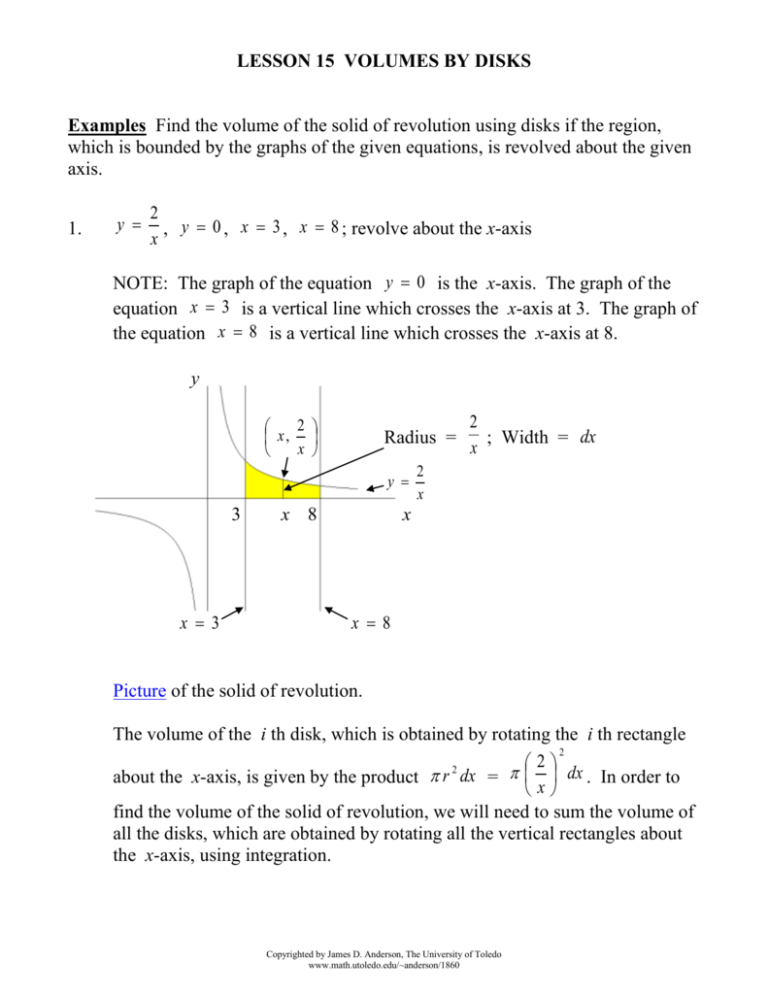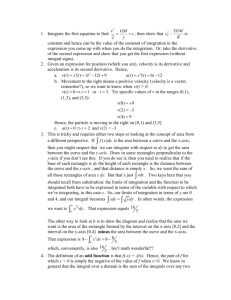LESSON X - The University of Toledo
advertisement

LESSON 15 VOLUMES BY DISKS Examples Find the volume of the solid of revolution using disks if the region, which is bounded by the graphs of the given equations, is revolved about the given axis. 1. y 2 , y 0 , x 3 , x 8 ; revolve about the x-axis x NOTE: The graph of the equation y 0 is the x-axis. The graph of the equation x 3 is a vertical line which crosses the x-axis at 3. The graph of the equation x 8 is a vertical line which crosses the x-axis at 8. y 2 x, x Radius = y 3 x 3 x 8 2 ; Width = dx x 2 x x x 8 Picture of the solid of revolution. The volume of the i th disk, which is obtained by rotating the i th rectangle 2 2 2 about the x-axis, is given by the product r dx = dx . In order to x find the volume of the solid of revolution, we will need to sum the volume of all the disks, which are obtained by rotating all the vertical rectangles about the x-axis, using integration. Copyrighted by James D. Anderson, The University of Toledo www.math.utoledo.edu/~anderson/1860 The first vertical rectangle in the region corresponds to when x 1 and the last vertical rectangle in the region corresponds to when x 4 . Thus, we sum from x 3 to x 8 . Thus, we obtain the following. 8 3 2 2 dx = x 8 8 3 4 dx = 4 x2 8 3 x1 1 2 4 = x dx = 4 = 1 3 x 3 8 8 1 1 5 5 1 4 = 4 = 4 = 3 6 x 3 8 24 5 Answer: 6 2. y 5 , y 0 , x 9 , x 4 ; revolve about the x-axis x NOTE: The graph of the equation y 0 is the x-axis. The graph of the equation x 9 is a vertical line which crosses the x-axis at 9 . The graph of the equation x 4 is a vertical line which crosses the x-axis at 4. 5 y y x x, 5 x Radius = 9 x 9 4 x x x 4 Picture of the solid of revolution. Copyrighted by James D. Anderson, The University of Toledo www.math.utoledo.edu/~anderson/1860 5 ; Width = dx x The volume of the i th disk, which is obtained by rotating the i th rectangle 2 5 2 dx . In order r dx about the x-axis, is given by the product = x to find the volume of the solid of revolution, we will need to sum the volume of all the disks, which are obtained by rotating all the vertical rectangles about the x-axis, using integration. The first vertical rectangle in the region corresponds to when x 9 and the last vertical rectangle in the region corresponds to when x 4 . Thus, we sum from x 9 to x 4 . Thus, we obtain the following. 4 9 2 5 x dx = 4 9 25 dx = 25 x 4 9 1 dx = 25 ln x x 25 ( ln 4 ln 9 ) = 25 ( ln 9 ln 4 ) = 25 ln Answer: 25 ln 3. 4 9 = 9 4 9 4 y 3x 2 , y 6 , x 0 ; revolve about the y-axis 2 NOTE: The graph of the equation y 3x is a parabola whose vertex is at the origin and opens downward. The graph of the equation y 6 is a horizontal line which crosses the y-axis at 6 . The graph of the equation x 0 is the y-axis. 2 y 3x 2 x y 3 x y y x 3 3 Copyrighted by James D. Anderson, The University of Toledo www.math.utoledo.edu/~anderson/1860 y x y y , y 3 6 y 3x 2 y 6 Radius = y ; Width = dy 3 Picture of the solid of revolution. The volume of the i th disk, which is obtained by rotating the i th rectangle 2 y 2 about the y-axis, is given by the product r dy = 3 dy . In order to find the volume of the solid of revolution, we will need to sum the volume of all the disks, which are obtained by rotating all the horizontal rectangles about the y-axis, using integration. The first horizontal rectangle in the region corresponds to when y 6 and the last horizontal rectangle in the region corresponds to when y 0 . Thus, we sum from y 6 to y 0 . Thus, we obtain the following. 2 0 6 y dy = 3 0 6 y dy = 3 3 0 0 6 y2 y dy = 3 2 6 = 0 y 2 6 = ( 0 36 ) = 6 6 6 Copyrighted by James D. Anderson, The University of Toledo www.math.utoledo.edu/~anderson/1860 Answer: 6 4. x 8 2 y , y 0 , y 3 , x 0 ; revolve about the y-axis NOTE: The graph of the equation x 8 2 y is a line whose y-intercept is the point ( 0 , 4 ) and whose x-intercept is the point ( 8 , 0 ) . The graph of the equation y 0 is the x-axis. The graph of the equation y 3 is a horizontal line which crosses the y-axis at 3. The graph of the equation x 0 is the y-axis. x 8 2y y 4 y 3 3 8 2 y, y y 8 x Radius = 8 2 y ; Width = dy Picture of the solid of revolution. NOTE: The solid is a circular cone with its top chopped off. The volume of the i th disk, which is obtained by rotating the i th rectangle 2 2 about the y-axis, is given by the product r dy = ( 8 2 y ) dy . In order to find the volume of the solid of revolution, we will need to sum the volume of all the disks, which are obtained by rotating all the horizontal rectangles about the y-axis, using integration. The first horizontal rectangle in the region corresponds to when y 0 and the last horizontal rectangle in the region corresponds to when y 3 . Thus, we sum from y 0 to y 3 . Thus, we obtain the following. Copyrighted by James D. Anderson, The University of Toledo www.math.utoledo.edu/~anderson/1860 3 0 4 ( 8 2 y ) 2 dy = 3 0 3 0 [ 2 ( 4 y ) ] 2 dy = 3 0 4 ( 4 y ) 2 dy = ( 4 y ) 2 dy Let u 4 y Then du dy 4 3 0 ( 4 y ) 2 dy = 4 4 u3 4 u3 = 4 3 = 3 1 3 0 ( 4 y ) 2 ( 1 ) dy = 4 4 1 = 1 4 u 2 du = 4 4 1 u 2 du 4 4 4 ( 64 1 ) = ( 63 ) = ( 21 ) = 3 3 1 84 Answer: 84 5. y x 2 6 x , y 0 ; revolve about the x-axis 2 NOTE: The graph of the equation y x 6 x is a parabola that opens upward from its vertex. We need to find the coordinates of this vertex. Since y x 2 6 x y x ( x 6 ) , then the x-coordinates of the x-intercepts of the graph of the parabola are x 0 and x 6 . Thus, the axis of symmetry for the parabola is the vertical line x 3 . Since the vertex of the parabola lies on this axis of symmetry, then the x-coordinate of the vertex is x 3 . Since y x ( x 6 ) , then we can find the x-coordinate for the vertex by y 3 ( 3 ) 9 . The graph of the equation y 0 is the x-axis. Copyrighted by James D. Anderson, The University of Toledo www.math.utoledo.edu/~anderson/1860 y y x2 6x x 6 x 2 Radius = x 6 x ; Width = dx ( x, x 2 6 x) Picture of the solid of revolution. Picture of half of the solid of revolution from x 0 to x 3 . The volume of the i th disk, which is obtained by rotating the i th rectangle 2 2 2 about the x-axis, is given by the product r dx = ( x 6 x ) dx . In order to find the volume of the solid of revolution, we will need to sum the volume of all the disks, which are obtained by rotating all the vertical rectangles about the x-axis, using integration. The first vertical rectangle in the region corresponds to when x 0 and the last vertical rectangle in the region corresponds to when x 6 . Thus, we sum from x 0 to x 6 . Thus, we obtain the following. 6 0 ( x 2 6 x ) 2 dx = x 5 12 x 4 36 x 3 5 4 3 6 0 ( x 4 12 x 3 36 x 2 ) dx = 6 x5 = 3 x 4 12 x 3 0 5 6 = 0 6 3 2 x x 15 x 60 0 = [ 216 ( 36 90 60 ) 0 ] = 5 5 1296 [ 216 ( 6 ) ] = 5 5 Copyrighted by James D. Anderson, The University of Toledo www.math.utoledo.edu/~anderson/1860 Answer: 6. 1296 5 y 2 sin 3 x , y 0 , x ; revolve about the x-axis 2 NOTE: The graph of the sine function y 2 sin 3 x has an amplitude of 2 2 and a period of . The graph of the equation y 0 is the x-axis. The 3 graph of the equation x is a vertical line which crosses the x-axis at . 2 2 y ( x , 2 sin 3 x ) 2 Radius = 2 sin 3 x ; Width = dx x 2 3 x 2 2 3 x Radius = 2 sin 3 x ( x , 2 sin 3 x ) Width = dx y 2 sin 3 x x 2 Picture of the solid of revolution. NOTE: The radius of the each disk, which is obtained by rotating a rectangle, for values of x between 0 and is 2 sin 3 x . The radius of the 3 each disk, which is obtained by rotating a rectangle, for values of x between 2 and is 2 sin 3 x . Thus, the square of radius is 4 sin 3 x for all 3 2 values of x between 0 and . 2 Copyrighted by James D. Anderson, The University of Toledo www.math.utoledo.edu/~anderson/1860 The volume of the i th disk, which is obtained by rotating the i th rectangle 2 2 about the x-axis, is given by the product r dx = ( 4 sin 3 x ) dx = 4 sin 2 3 x dx . In order to find the volume of the solid of revolution, we will need to sum the volume of all the disks, which are obtained by rotating all the vertical rectangles about the x-axis, using integration. The first vertical rectangle in the region corresponds to when x 0 and the last vertical rectangle in the region corresponds to when x . Thus, we 2 sum from x 0 to x . Thus, we obtain the following. 2 /2 0 4 sin 2 3 x dx = 4 /2 0 sin 2 3 x dx Let u 3 x Then du 3 dx 4 /2 0 4 3 sin 2 3 x dx = 3 / 2 4 u sin 2 u 3 2 4 0 3 / 2 ( 2 u sin 2 u ) 3 0 = /2 0 sin 2 3 x 3 dx = 4 3 3 / 2 0 sin 2 u du = 3 / 2 4 1 ( 2 u sin 2 u ) = 3 4 0 = [ 3 sin 3 ( 0 sin 0 ) ] = 3 [ 3 0 ( 0 0 ) ] = ( 3 ) 2 3 3 Answer: 7. 2 x cos y , x 0 , y , y ; revolve about the y-axis Copyrighted by James D. Anderson, The University of Toledo www.math.utoledo.edu/~anderson/1860 NOTE: The graph of the cosine function x cos y has an amplitude of 1 and a period of 2 . The graph of the equation x 0 is the y-axis. The graph of the equation y is a horizontal line which crosses the y-axis at . The graph of the equation y is a horizontal line which crosses the y-axis at . y x cos y ( cos y , y ) y y 2 ( cos y , y ) x y Radius = cos y Width = dy 2 ( cos y , y ) Radius = cos y ; Width = dy y y Picture of the solid of revolution. NOTE: The radius of the each disk, which is obtained by rotating a rectangle, for values of y between and is cos y . The radius of the 2 2 each disk, which is obtained by rotating a rectangle, for values of y between and is cos y . The radius of the each disk, which is obtained by 2 rotating a rectangle, for values of y between and is also cos y . 2 2 Thus, the square of radius is co s y for all values of y between and . Copyrighted by James D. Anderson, The University of Toledo www.math.utoledo.edu/~anderson/1860 The volume of the i th disk, which is obtained by rotating the i th rectangle 2 about the y-axis, is given by the product r dy = cos y dy . In order to find the volume of the solid of revolution, we will need to sum the volume of all the disks, which are obtained by rotating all the horizontal rectangles about the y-axis, using integration. The first horizontal rectangle in the region corresponds to when y and the last horizontal rectangle in the region corresponds to when y . Thus, we sum from y to y . Thus, we obtain the following. cos 2 y dy = cos 2 y dy = 2 0 cos 2 y dy since the integrand is even 2 0 2 u sin 2 u ( 2 u sin 2 u ) = cos 2 y dy = 2 = 4 0 4 2 0 ( 2 u sin 2 u ) = [ 2 sin 2 ( 0 sin 0 ) ] = 2 2 0 [ 2 0 ( 0 0 ) ] = ( 2 ) 2 2 2 Answer: 8. 2 y ln 4 x and y ln 20 ; revolve about the y-axis 1 . The graph of the 4 equation y ln 20 is a horizontal line which crosses the y-axis at ln 20 . The graph of y ln 4 x crosses the x-axis at x Since we are rotating the region about the y-axis, our rectangles will be horizontal. In order to measure horizontal lengths, we use the x-coordinates of points. Thus, we will need to solve for x in the equation y ln 4 x . Copyrighted by James D. Anderson, The University of Toledo www.math.utoledo.edu/~anderson/1860 y ln 4 x 4 x e y x 1 y e 4 y ln 4 x y y ln 20 ln 20 1 y e , y 4 y 1 4 5 x 1 y e ; Width = dy 4 Radius = Picture of the solid of revolution. NOTE: The region is not bounded below. Thus, the lower limit of integration will be negative infinity. The volume of the i th disk, which is obtained by rotating the i th rectangle 2 1 y 2 about the y-axis, is given by the product r dy = e dy . In order 4 to find the volume of the solid of revolution, we will need to sum the volume of all the disks, which are obtained by rotating all the horizontal rectangles about the y-axis, using integration. The first horizontal rectangle in the region corresponds to when y and the last horizontal rectangle in the region corresponds to when y ln 20 . Thus, we sum from y to y ln 20 . Thus, we obtain the following. ln 20 2 1 e y dy = 4 ln 20 ln 20 2 y 1 e 2 y dy = e dy = 16 16 Copyrighted by James D. Anderson, The University of Toledo www.math.utoledo.edu/~anderson/1860 ln 20 1 lim e 2 y lim e 2 y dy = 16 t 2 16 t t t ln 20 = lim ( e 2 ln 20 e 2 t ) = 32 t 400 lim ( e ln 400 e 2 t ) = lim ( 400 e 2 t ) = ( 400 0 ) = = 32 t 32 t 32 32 100 25 = 2 8 2 NOTE: e 2 ln 20 = exp( 2 ln 20 ) = exp( ln 20 ) = exp( ln 400 ) 400 lim e 2 t 0 t Answer: 25 2 Copyrighted by James D. Anderson, The University of Toledo www.math.utoledo.edu/~anderson/1860








